Policy Briefing: Enhancing Health Outcomes for Indigenous Australians
VerifiedAdded on 2022/11/10
|7
|1787
|75
Report
AI Summary
This report is a briefing note prepared for the Minister for Health, focusing on the critical need for a comprehensive health policy to enhance the health and wellness outcomes of Indigenous Australians, going beyond the current 'Closing the Gap' strategy. The report highlights the failures of the 'Closing the Gap' approach in addressing key health indicators such as child mortality, school attendance, and life expectancy, and the underlying issues of bureaucratic inefficiency and unrealistic objectives. It identifies significant disparities in healthcare access, employment, and education, emphasizing the need for targeted interventions. The report presents four policy options: increasing employment opportunities, improving education, conducting performance audits, and increasing employment in healthcare. It recommends prioritizing education and employment initiatives, supported by appropriate budget allocations, to foster long-term wellness and equity for Indigenous communities, ultimately advocating for a more inclusive and effective approach to Indigenous health.
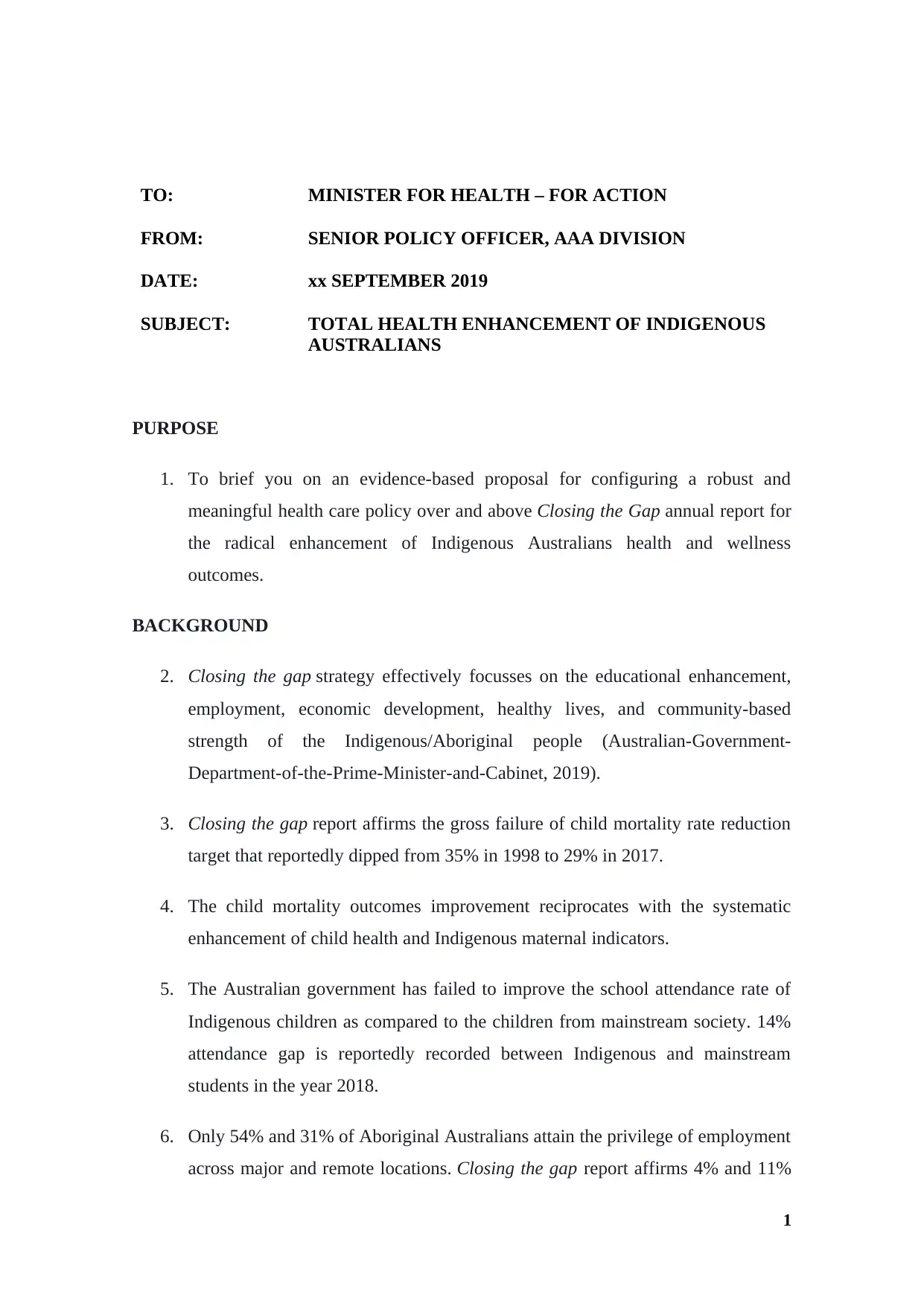
TO: MINISTER FOR HEALTH – FOR ACTION
FROM: SENIOR POLICY OFFICER, AAA DIVISION
DATE: xx SEPTEMBER 2019
SUBJECT: TOTAL HEALTH ENHANCEMENT OF INDIGENOUS
AUSTRALIANS
PURPOSE
1. To brief you on an evidence-based proposal for configuring a robust and
meaningful health care policy over and above Closing the Gap annual report for
the radical enhancement of Indigenous Australians health and wellness
outcomes.
BACKGROUND
2. Closing the gap strategy effectively focusses on the educational enhancement,
employment, economic development, healthy lives, and community-based
strength of the Indigenous/Aboriginal people (Australian-Government-
Department-of-the-Prime-Minister-and-Cabinet, 2019).
3. Closing the gap report affirms the gross failure of child mortality rate reduction
target that reportedly dipped from 35% in 1998 to 29% in 2017.
4. The child mortality outcomes improvement reciprocates with the systematic
enhancement of child health and Indigenous maternal indicators.
5. The Australian government has failed to improve the school attendance rate of
Indigenous children as compared to the children from mainstream society. 14%
attendance gap is reportedly recorded between Indigenous and mainstream
students in the year 2018.
6. Only 54% and 31% of Aboriginal Australians attain the privilege of employment
across major and remote locations. Closing the gap report affirms 4% and 11%
1
FROM: SENIOR POLICY OFFICER, AAA DIVISION
DATE: xx SEPTEMBER 2019
SUBJECT: TOTAL HEALTH ENHANCEMENT OF INDIGENOUS
AUSTRALIANS
PURPOSE
1. To brief you on an evidence-based proposal for configuring a robust and
meaningful health care policy over and above Closing the Gap annual report for
the radical enhancement of Indigenous Australians health and wellness
outcomes.
BACKGROUND
2. Closing the gap strategy effectively focusses on the educational enhancement,
employment, economic development, healthy lives, and community-based
strength of the Indigenous/Aboriginal people (Australian-Government-
Department-of-the-Prime-Minister-and-Cabinet, 2019).
3. Closing the gap report affirms the gross failure of child mortality rate reduction
target that reportedly dipped from 35% in 1998 to 29% in 2017.
4. The child mortality outcomes improvement reciprocates with the systematic
enhancement of child health and Indigenous maternal indicators.
5. The Australian government has failed to improve the school attendance rate of
Indigenous children as compared to the children from mainstream society. 14%
attendance gap is reportedly recorded between Indigenous and mainstream
students in the year 2018.
6. Only 54% and 31% of Aboriginal Australians attain the privilege of employment
across major and remote locations. Closing the gap report affirms 4% and 11%
1
Paraphrase This Document
Need a fresh take? Get an instant paraphrase of this document with our AI Paraphraser
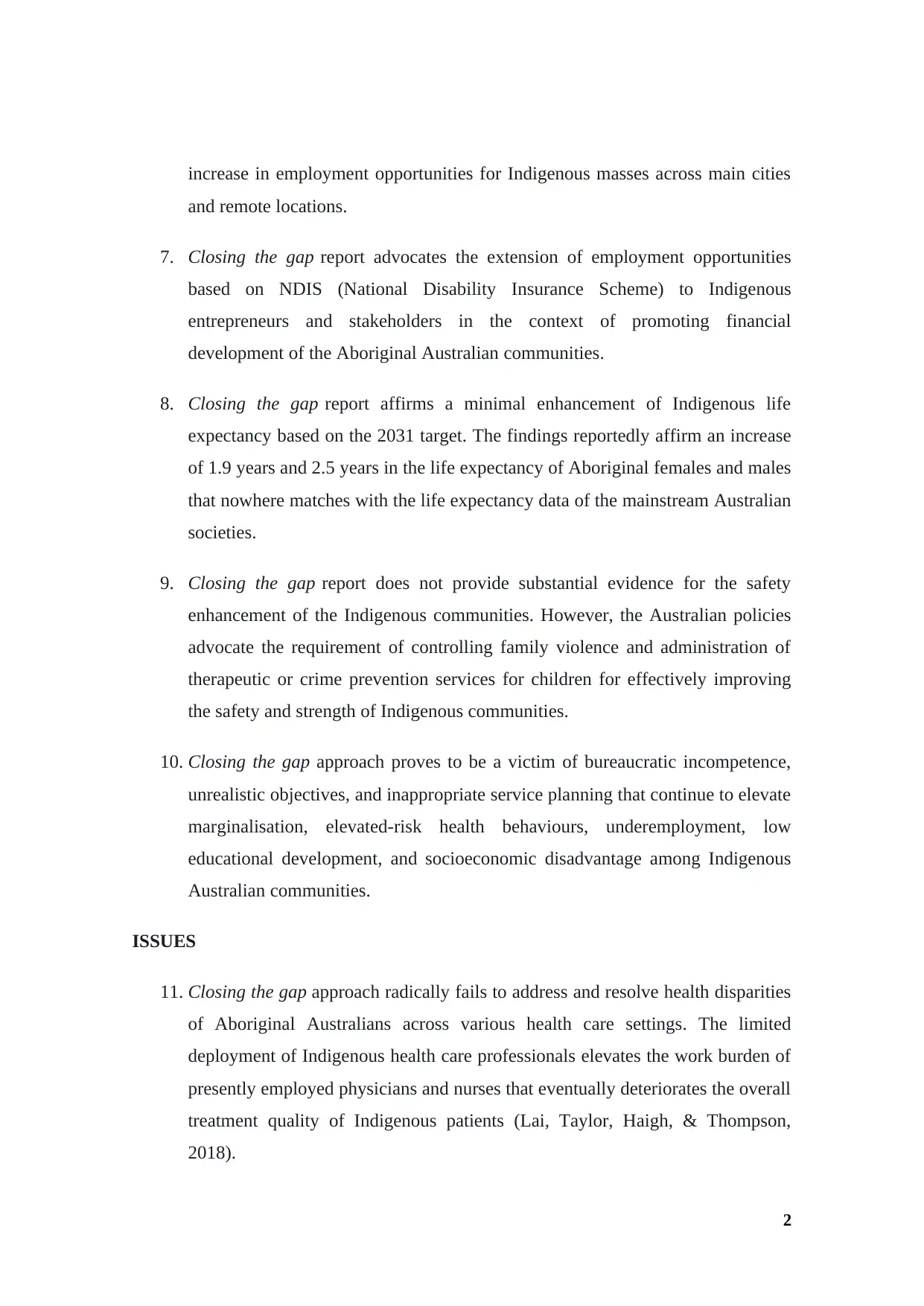
increase in employment opportunities for Indigenous masses across main cities
and remote locations.
7. Closing the gap report advocates the extension of employment opportunities
based on NDIS (National Disability Insurance Scheme) to Indigenous
entrepreneurs and stakeholders in the context of promoting financial
development of the Aboriginal Australian communities.
8. Closing the gap report affirms a minimal enhancement of Indigenous life
expectancy based on the 2031 target. The findings reportedly affirm an increase
of 1.9 years and 2.5 years in the life expectancy of Aboriginal females and males
that nowhere matches with the life expectancy data of the mainstream Australian
societies.
9. Closing the gap report does not provide substantial evidence for the safety
enhancement of the Indigenous communities. However, the Australian policies
advocate the requirement of controlling family violence and administration of
therapeutic or crime prevention services for children for effectively improving
the safety and strength of Indigenous communities.
10. Closing the gap approach proves to be a victim of bureaucratic incompetence,
unrealistic objectives, and inappropriate service planning that continue to elevate
marginalisation, elevated-risk health behaviours, underemployment, low
educational development, and socioeconomic disadvantage among Indigenous
Australian communities.
ISSUES
11. Closing the gap approach radically fails to address and resolve health disparities
of Aboriginal Australians across various health care settings. The limited
deployment of Indigenous health care professionals elevates the work burden of
presently employed physicians and nurses that eventually deteriorates the overall
treatment quality of Indigenous patients (Lai, Taylor, Haigh, & Thompson,
2018).
2
and remote locations.
7. Closing the gap report advocates the extension of employment opportunities
based on NDIS (National Disability Insurance Scheme) to Indigenous
entrepreneurs and stakeholders in the context of promoting financial
development of the Aboriginal Australian communities.
8. Closing the gap report affirms a minimal enhancement of Indigenous life
expectancy based on the 2031 target. The findings reportedly affirm an increase
of 1.9 years and 2.5 years in the life expectancy of Aboriginal females and males
that nowhere matches with the life expectancy data of the mainstream Australian
societies.
9. Closing the gap report does not provide substantial evidence for the safety
enhancement of the Indigenous communities. However, the Australian policies
advocate the requirement of controlling family violence and administration of
therapeutic or crime prevention services for children for effectively improving
the safety and strength of Indigenous communities.
10. Closing the gap approach proves to be a victim of bureaucratic incompetence,
unrealistic objectives, and inappropriate service planning that continue to elevate
marginalisation, elevated-risk health behaviours, underemployment, low
educational development, and socioeconomic disadvantage among Indigenous
Australian communities.
ISSUES
11. Closing the gap approach radically fails to address and resolve health disparities
of Aboriginal Australians across various health care settings. The limited
deployment of Indigenous health care professionals elevates the work burden of
presently employed physicians and nurses that eventually deteriorates the overall
treatment quality of Indigenous patients (Lai, Taylor, Haigh, & Thompson,
2018).
2
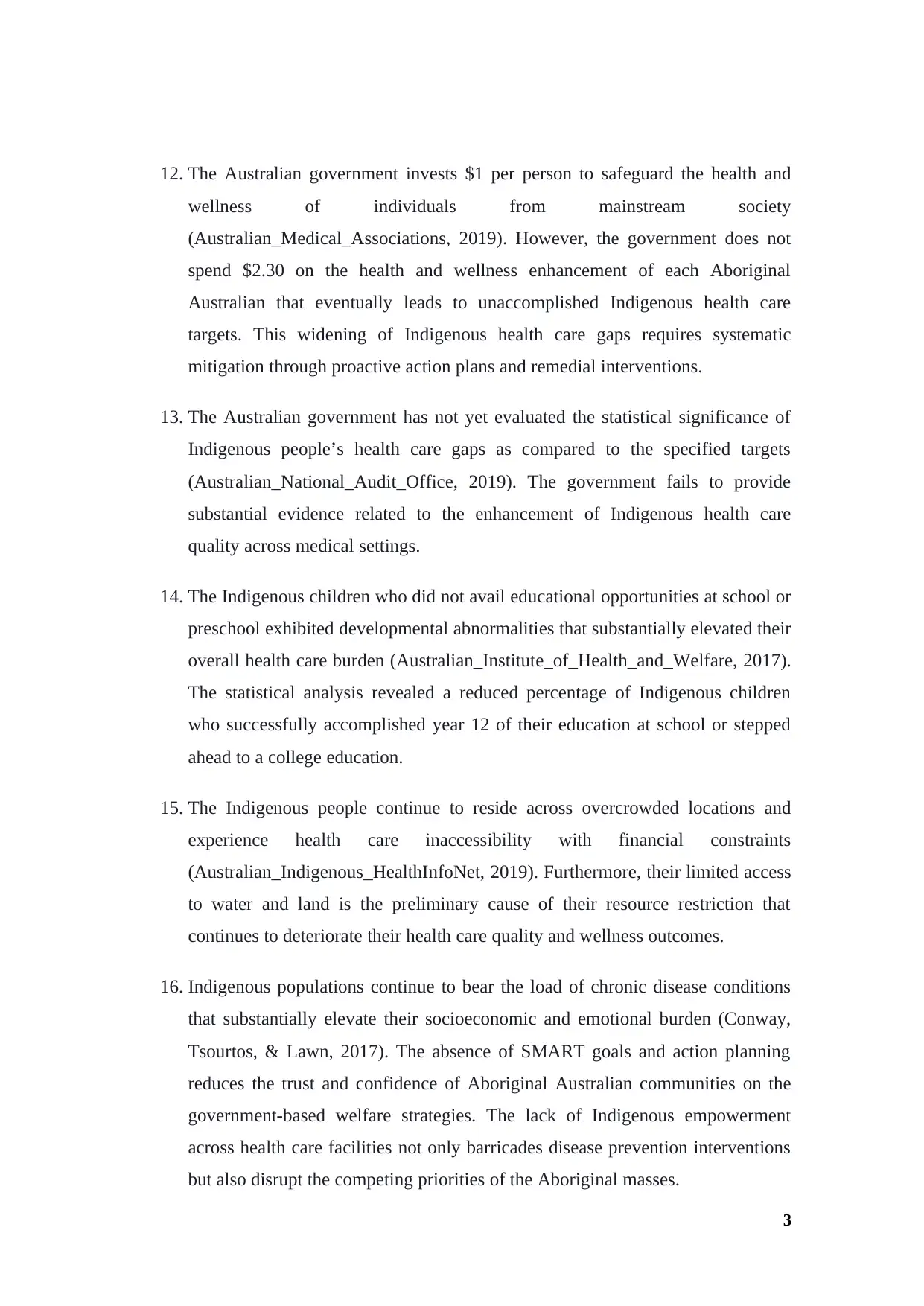
12. The Australian government invests $1 per person to safeguard the health and
wellness of individuals from mainstream society
(Australian_Medical_Associations, 2019). However, the government does not
spend $2.30 on the health and wellness enhancement of each Aboriginal
Australian that eventually leads to unaccomplished Indigenous health care
targets. This widening of Indigenous health care gaps requires systematic
mitigation through proactive action plans and remedial interventions.
13. The Australian government has not yet evaluated the statistical significance of
Indigenous people’s health care gaps as compared to the specified targets
(Australian_National_Audit_Office, 2019). The government fails to provide
substantial evidence related to the enhancement of Indigenous health care
quality across medical settings.
14. The Indigenous children who did not avail educational opportunities at school or
preschool exhibited developmental abnormalities that substantially elevated their
overall health care burden (Australian_Institute_of_Health_and_Welfare, 2017).
The statistical analysis revealed a reduced percentage of Indigenous children
who successfully accomplished year 12 of their education at school or stepped
ahead to a college education.
15. The Indigenous people continue to reside across overcrowded locations and
experience health care inaccessibility with financial constraints
(Australian_Indigenous_HealthInfoNet, 2019). Furthermore, their limited access
to water and land is the preliminary cause of their resource restriction that
continues to deteriorate their health care quality and wellness outcomes.
16. Indigenous populations continue to bear the load of chronic disease conditions
that substantially elevate their socioeconomic and emotional burden (Conway,
Tsourtos, & Lawn, 2017). The absence of SMART goals and action planning
reduces the trust and confidence of Aboriginal Australian communities on the
government-based welfare strategies. The lack of Indigenous empowerment
across health care facilities not only barricades disease prevention interventions
but also disrupt the competing priorities of the Aboriginal masses.
3
wellness of individuals from mainstream society
(Australian_Medical_Associations, 2019). However, the government does not
spend $2.30 on the health and wellness enhancement of each Aboriginal
Australian that eventually leads to unaccomplished Indigenous health care
targets. This widening of Indigenous health care gaps requires systematic
mitigation through proactive action plans and remedial interventions.
13. The Australian government has not yet evaluated the statistical significance of
Indigenous people’s health care gaps as compared to the specified targets
(Australian_National_Audit_Office, 2019). The government fails to provide
substantial evidence related to the enhancement of Indigenous health care
quality across medical settings.
14. The Indigenous children who did not avail educational opportunities at school or
preschool exhibited developmental abnormalities that substantially elevated their
overall health care burden (Australian_Institute_of_Health_and_Welfare, 2017).
The statistical analysis revealed a reduced percentage of Indigenous children
who successfully accomplished year 12 of their education at school or stepped
ahead to a college education.
15. The Indigenous people continue to reside across overcrowded locations and
experience health care inaccessibility with financial constraints
(Australian_Indigenous_HealthInfoNet, 2019). Furthermore, their limited access
to water and land is the preliminary cause of their resource restriction that
continues to deteriorate their health care quality and wellness outcomes.
16. Indigenous populations continue to bear the load of chronic disease conditions
that substantially elevate their socioeconomic and emotional burden (Conway,
Tsourtos, & Lawn, 2017). The absence of SMART goals and action planning
reduces the trust and confidence of Aboriginal Australian communities on the
government-based welfare strategies. The lack of Indigenous empowerment
across health care facilities not only barricades disease prevention interventions
but also disrupt the competing priorities of the Aboriginal masses.
3
⊘ This is a preview!⊘
Do you want full access?
Subscribe today to unlock all pages.

Trusted by 1+ million students worldwide
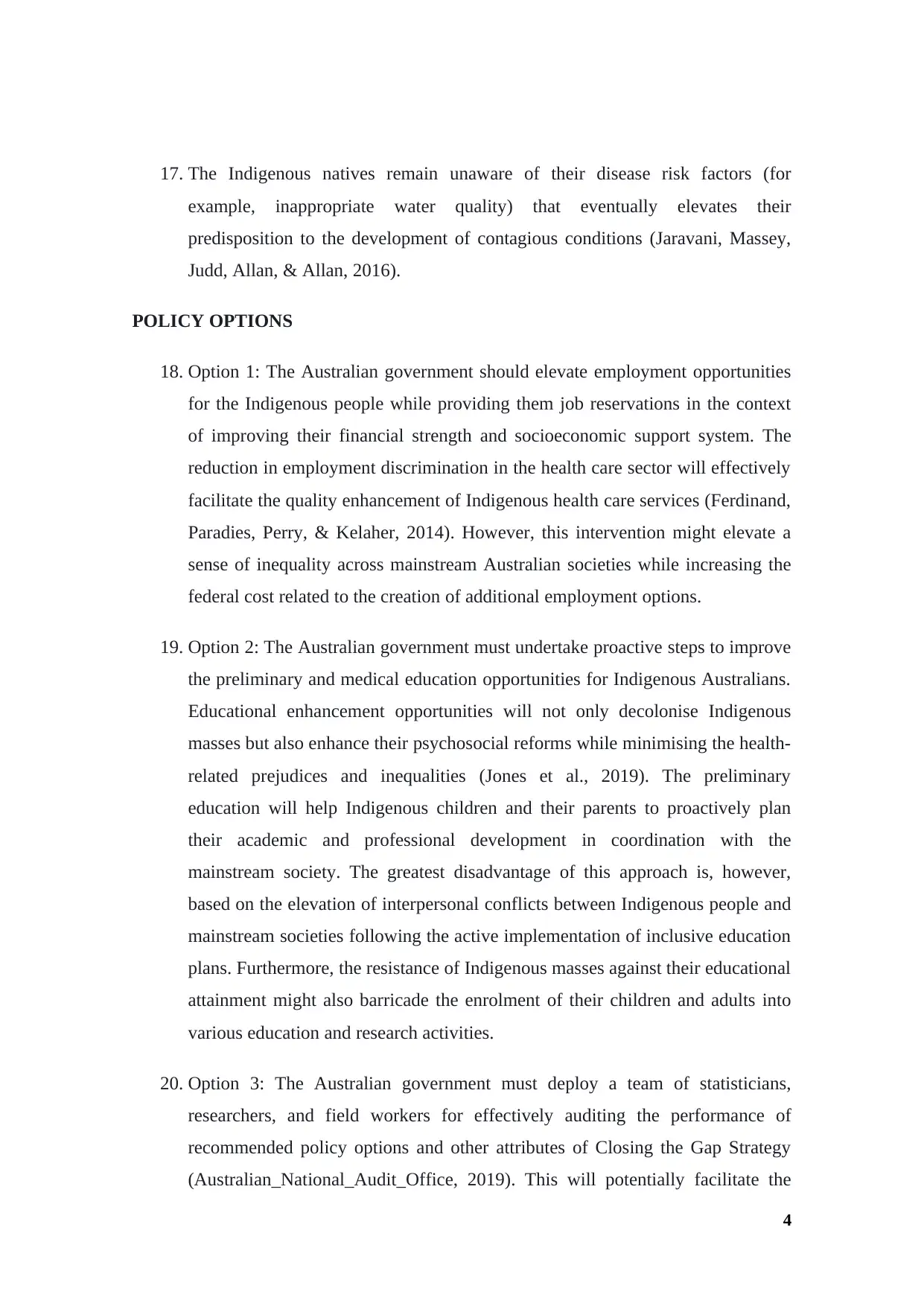
17. The Indigenous natives remain unaware of their disease risk factors (for
example, inappropriate water quality) that eventually elevates their
predisposition to the development of contagious conditions (Jaravani, Massey,
Judd, Allan, & Allan, 2016).
POLICY OPTIONS
18. Option 1: The Australian government should elevate employment opportunities
for the Indigenous people while providing them job reservations in the context
of improving their financial strength and socioeconomic support system. The
reduction in employment discrimination in the health care sector will effectively
facilitate the quality enhancement of Indigenous health care services (Ferdinand,
Paradies, Perry, & Kelaher, 2014). However, this intervention might elevate a
sense of inequality across mainstream Australian societies while increasing the
federal cost related to the creation of additional employment options.
19. Option 2: The Australian government must undertake proactive steps to improve
the preliminary and medical education opportunities for Indigenous Australians.
Educational enhancement opportunities will not only decolonise Indigenous
masses but also enhance their psychosocial reforms while minimising the health-
related prejudices and inequalities (Jones et al., 2019). The preliminary
education will help Indigenous children and their parents to proactively plan
their academic and professional development in coordination with the
mainstream society. The greatest disadvantage of this approach is, however,
based on the elevation of interpersonal conflicts between Indigenous people and
mainstream societies following the active implementation of inclusive education
plans. Furthermore, the resistance of Indigenous masses against their educational
attainment might also barricade the enrolment of their children and adults into
various education and research activities.
20. Option 3: The Australian government must deploy a team of statisticians,
researchers, and field workers for effectively auditing the performance of
recommended policy options and other attributes of Closing the Gap Strategy
(Australian_National_Audit_Office, 2019). This will potentially facilitate the
4
example, inappropriate water quality) that eventually elevates their
predisposition to the development of contagious conditions (Jaravani, Massey,
Judd, Allan, & Allan, 2016).
POLICY OPTIONS
18. Option 1: The Australian government should elevate employment opportunities
for the Indigenous people while providing them job reservations in the context
of improving their financial strength and socioeconomic support system. The
reduction in employment discrimination in the health care sector will effectively
facilitate the quality enhancement of Indigenous health care services (Ferdinand,
Paradies, Perry, & Kelaher, 2014). However, this intervention might elevate a
sense of inequality across mainstream Australian societies while increasing the
federal cost related to the creation of additional employment options.
19. Option 2: The Australian government must undertake proactive steps to improve
the preliminary and medical education opportunities for Indigenous Australians.
Educational enhancement opportunities will not only decolonise Indigenous
masses but also enhance their psychosocial reforms while minimising the health-
related prejudices and inequalities (Jones et al., 2019). The preliminary
education will help Indigenous children and their parents to proactively plan
their academic and professional development in coordination with the
mainstream society. The greatest disadvantage of this approach is, however,
based on the elevation of interpersonal conflicts between Indigenous people and
mainstream societies following the active implementation of inclusive education
plans. Furthermore, the resistance of Indigenous masses against their educational
attainment might also barricade the enrolment of their children and adults into
various education and research activities.
20. Option 3: The Australian government must deploy a team of statisticians,
researchers, and field workers for effectively auditing the performance of
recommended policy options and other attributes of Closing the Gap Strategy
(Australian_National_Audit_Office, 2019). This will potentially facilitate the
4
Paraphrase This Document
Need a fresh take? Get an instant paraphrase of this document with our AI Paraphraser
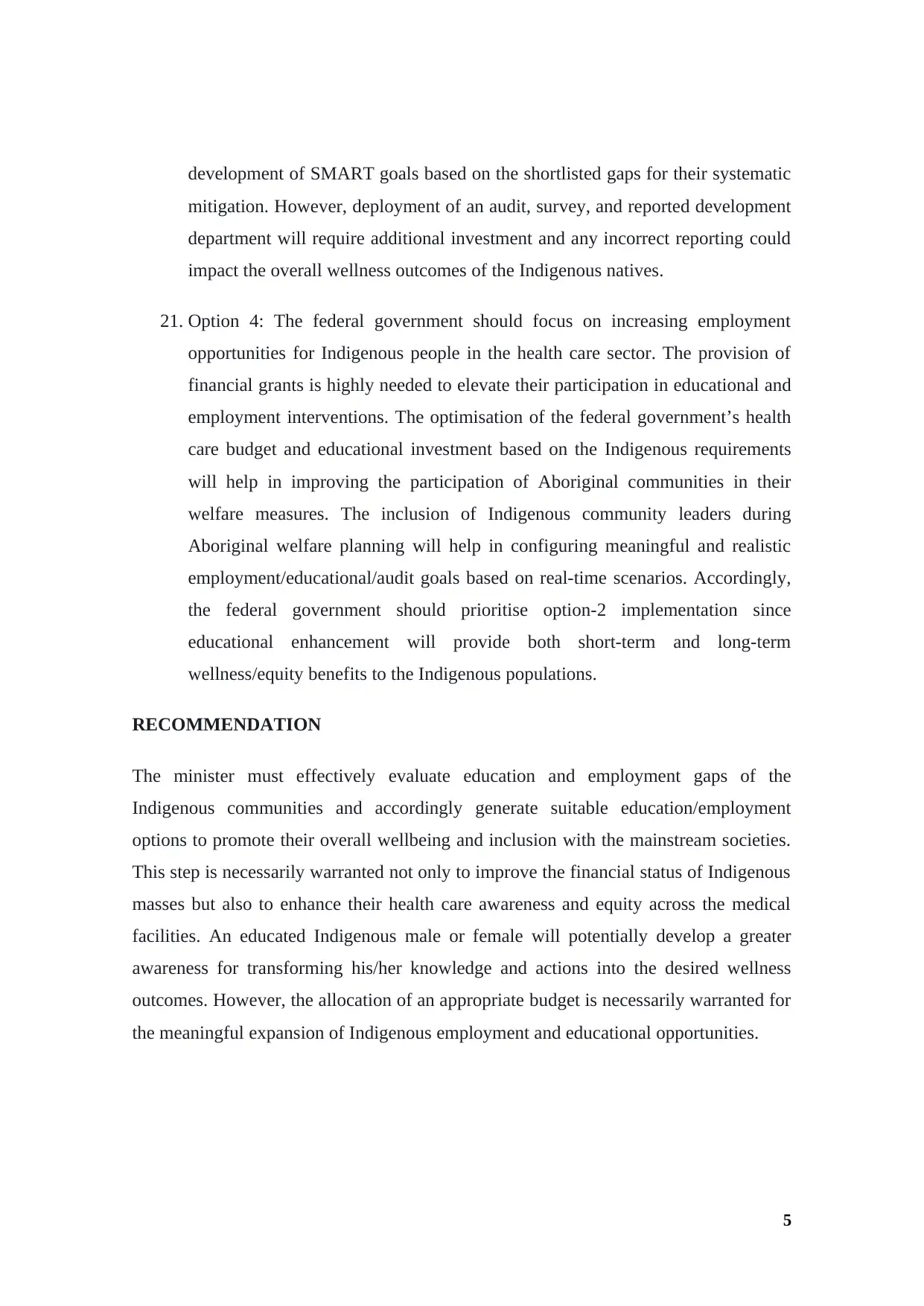
development of SMART goals based on the shortlisted gaps for their systematic
mitigation. However, deployment of an audit, survey, and reported development
department will require additional investment and any incorrect reporting could
impact the overall wellness outcomes of the Indigenous natives.
21. Option 4: The federal government should focus on increasing employment
opportunities for Indigenous people in the health care sector. The provision of
financial grants is highly needed to elevate their participation in educational and
employment interventions. The optimisation of the federal government’s health
care budget and educational investment based on the Indigenous requirements
will help in improving the participation of Aboriginal communities in their
welfare measures. The inclusion of Indigenous community leaders during
Aboriginal welfare planning will help in configuring meaningful and realistic
employment/educational/audit goals based on real-time scenarios. Accordingly,
the federal government should prioritise option-2 implementation since
educational enhancement will provide both short-term and long-term
wellness/equity benefits to the Indigenous populations.
RECOMMENDATION
The minister must effectively evaluate education and employment gaps of the
Indigenous communities and accordingly generate suitable education/employment
options to promote their overall wellbeing and inclusion with the mainstream societies.
This step is necessarily warranted not only to improve the financial status of Indigenous
masses but also to enhance their health care awareness and equity across the medical
facilities. An educated Indigenous male or female will potentially develop a greater
awareness for transforming his/her knowledge and actions into the desired wellness
outcomes. However, the allocation of an appropriate budget is necessarily warranted for
the meaningful expansion of Indigenous employment and educational opportunities.
5
mitigation. However, deployment of an audit, survey, and reported development
department will require additional investment and any incorrect reporting could
impact the overall wellness outcomes of the Indigenous natives.
21. Option 4: The federal government should focus on increasing employment
opportunities for Indigenous people in the health care sector. The provision of
financial grants is highly needed to elevate their participation in educational and
employment interventions. The optimisation of the federal government’s health
care budget and educational investment based on the Indigenous requirements
will help in improving the participation of Aboriginal communities in their
welfare measures. The inclusion of Indigenous community leaders during
Aboriginal welfare planning will help in configuring meaningful and realistic
employment/educational/audit goals based on real-time scenarios. Accordingly,
the federal government should prioritise option-2 implementation since
educational enhancement will provide both short-term and long-term
wellness/equity benefits to the Indigenous populations.
RECOMMENDATION
The minister must effectively evaluate education and employment gaps of the
Indigenous communities and accordingly generate suitable education/employment
options to promote their overall wellbeing and inclusion with the mainstream societies.
This step is necessarily warranted not only to improve the financial status of Indigenous
masses but also to enhance their health care awareness and equity across the medical
facilities. An educated Indigenous male or female will potentially develop a greater
awareness for transforming his/her knowledge and actions into the desired wellness
outcomes. However, the allocation of an appropriate budget is necessarily warranted for
the meaningful expansion of Indigenous employment and educational opportunities.
5
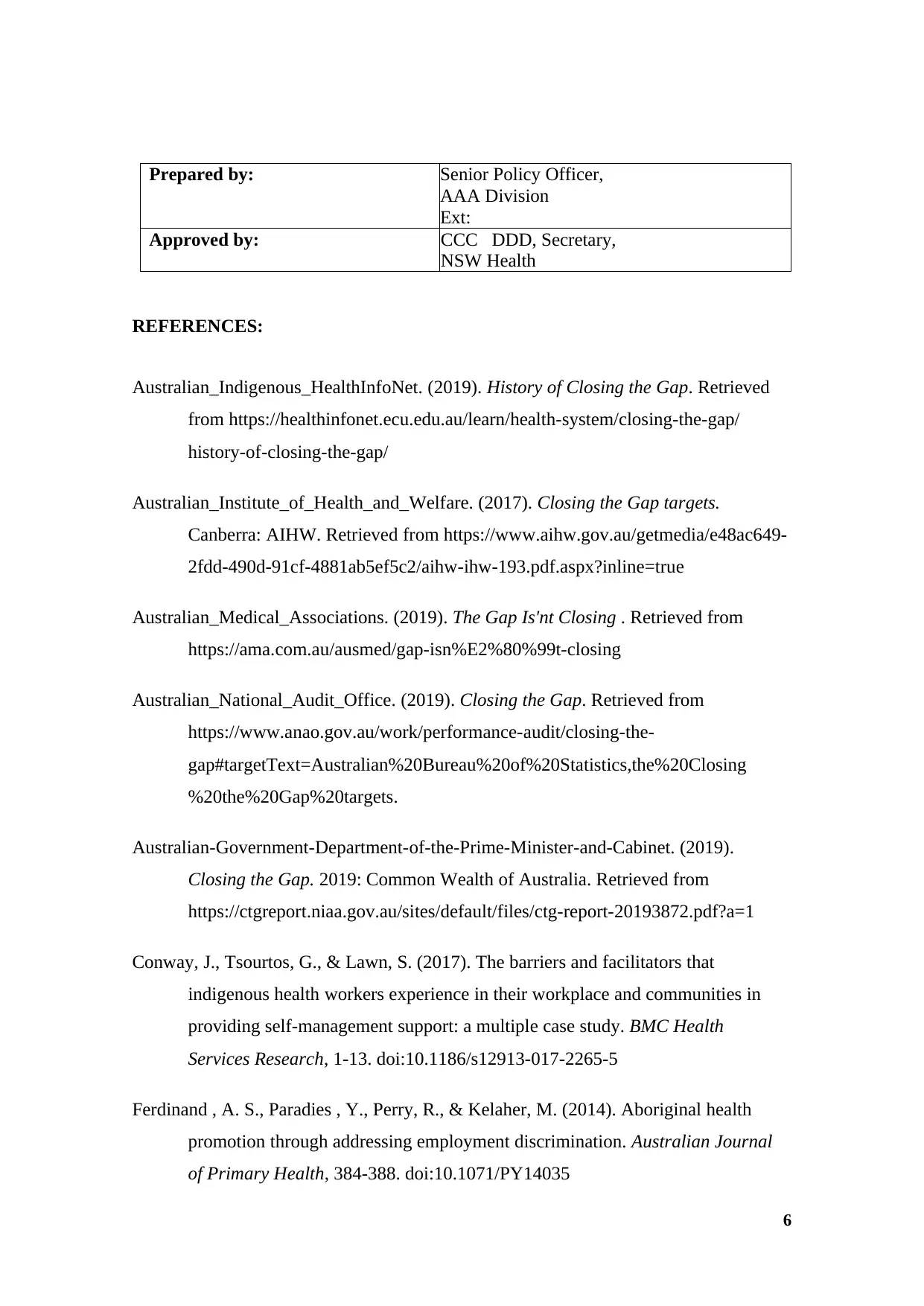
Prepared by: Senior Policy Officer,
AAA Division
Ext:
Approved by: CCC DDD, Secretary,
NSW Health
REFERENCES:
Australian_Indigenous_HealthInfoNet. (2019). History of Closing the Gap. Retrieved
from https://healthinfonet.ecu.edu.au/learn/health-system/closing-the-gap/
history-of-closing-the-gap/
Australian_Institute_of_Health_and_Welfare. (2017). Closing the Gap targets.
Canberra: AIHW. Retrieved from https://www.aihw.gov.au/getmedia/e48ac649-
2fdd-490d-91cf-4881ab5ef5c2/aihw-ihw-193.pdf.aspx?inline=true
Australian_Medical_Associations. (2019). The Gap Is'nt Closing . Retrieved from
https://ama.com.au/ausmed/gap-isn%E2%80%99t-closing
Australian_National_Audit_Office. (2019). Closing the Gap. Retrieved from
https://www.anao.gov.au/work/performance-audit/closing-the-
gap#targetText=Australian%20Bureau%20of%20Statistics,the%20Closing
%20the%20Gap%20targets.
Australian-Government-Department-of-the-Prime-Minister-and-Cabinet. (2019).
Closing the Gap. 2019: Common Wealth of Australia. Retrieved from
https://ctgreport.niaa.gov.au/sites/default/files/ctg-report-20193872.pdf?a=1
Conway, J., Tsourtos, G., & Lawn, S. (2017). The barriers and facilitators that
indigenous health workers experience in their workplace and communities in
providing self-management support: a multiple case study. BMC Health
Services Research, 1-13. doi:10.1186/s12913-017-2265-5
Ferdinand , A. S., Paradies , Y., Perry, R., & Kelaher, M. (2014). Aboriginal health
promotion through addressing employment discrimination. Australian Journal
of Primary Health, 384-388. doi:10.1071/PY14035
6
AAA Division
Ext:
Approved by: CCC DDD, Secretary,
NSW Health
REFERENCES:
Australian_Indigenous_HealthInfoNet. (2019). History of Closing the Gap. Retrieved
from https://healthinfonet.ecu.edu.au/learn/health-system/closing-the-gap/
history-of-closing-the-gap/
Australian_Institute_of_Health_and_Welfare. (2017). Closing the Gap targets.
Canberra: AIHW. Retrieved from https://www.aihw.gov.au/getmedia/e48ac649-
2fdd-490d-91cf-4881ab5ef5c2/aihw-ihw-193.pdf.aspx?inline=true
Australian_Medical_Associations. (2019). The Gap Is'nt Closing . Retrieved from
https://ama.com.au/ausmed/gap-isn%E2%80%99t-closing
Australian_National_Audit_Office. (2019). Closing the Gap. Retrieved from
https://www.anao.gov.au/work/performance-audit/closing-the-
gap#targetText=Australian%20Bureau%20of%20Statistics,the%20Closing
%20the%20Gap%20targets.
Australian-Government-Department-of-the-Prime-Minister-and-Cabinet. (2019).
Closing the Gap. 2019: Common Wealth of Australia. Retrieved from
https://ctgreport.niaa.gov.au/sites/default/files/ctg-report-20193872.pdf?a=1
Conway, J., Tsourtos, G., & Lawn, S. (2017). The barriers and facilitators that
indigenous health workers experience in their workplace and communities in
providing self-management support: a multiple case study. BMC Health
Services Research, 1-13. doi:10.1186/s12913-017-2265-5
Ferdinand , A. S., Paradies , Y., Perry, R., & Kelaher, M. (2014). Aboriginal health
promotion through addressing employment discrimination. Australian Journal
of Primary Health, 384-388. doi:10.1071/PY14035
6
⊘ This is a preview!⊘
Do you want full access?
Subscribe today to unlock all pages.

Trusted by 1+ million students worldwide
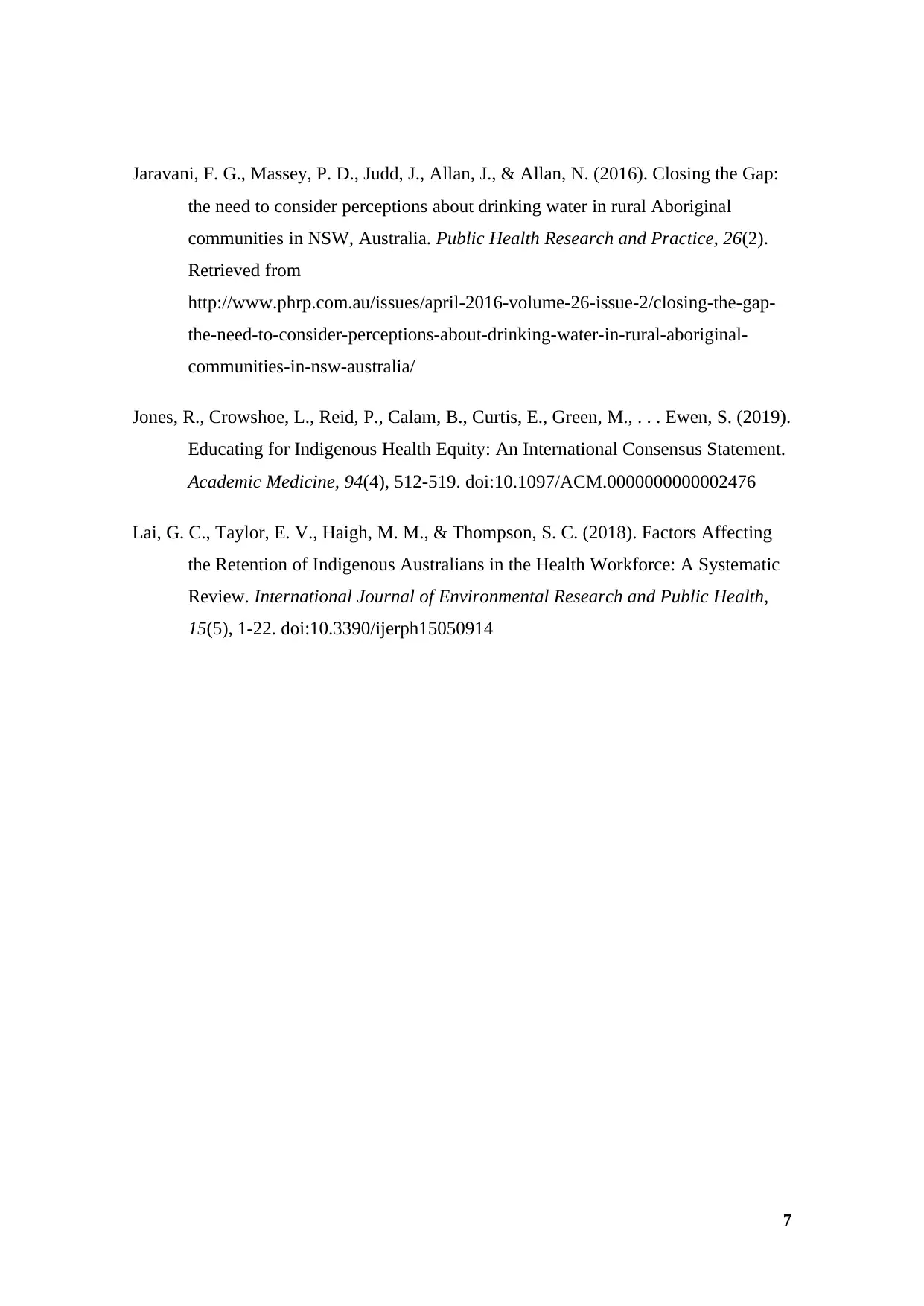
Jaravani, F. G., Massey, P. D., Judd, J., Allan, J., & Allan, N. (2016). Closing the Gap:
the need to consider perceptions about drinking water in rural Aboriginal
communities in NSW, Australia. Public Health Research and Practice, 26(2).
Retrieved from
http://www.phrp.com.au/issues/april-2016-volume-26-issue-2/closing-the-gap-
the-need-to-consider-perceptions-about-drinking-water-in-rural-aboriginal-
communities-in-nsw-australia/
Jones, R., Crowshoe, L., Reid, P., Calam, B., Curtis, E., Green, M., . . . Ewen, S. (2019).
Educating for Indigenous Health Equity: An International Consensus Statement.
Academic Medicine, 94(4), 512-519. doi:10.1097/ACM.0000000000002476
Lai, G. C., Taylor, E. V., Haigh, M. M., & Thompson, S. C. (2018). Factors Affecting
the Retention of Indigenous Australians in the Health Workforce: A Systematic
Review. International Journal of Environmental Research and Public Health,
15(5), 1-22. doi:10.3390/ijerph15050914
7
the need to consider perceptions about drinking water in rural Aboriginal
communities in NSW, Australia. Public Health Research and Practice, 26(2).
Retrieved from
http://www.phrp.com.au/issues/april-2016-volume-26-issue-2/closing-the-gap-
the-need-to-consider-perceptions-about-drinking-water-in-rural-aboriginal-
communities-in-nsw-australia/
Jones, R., Crowshoe, L., Reid, P., Calam, B., Curtis, E., Green, M., . . . Ewen, S. (2019).
Educating for Indigenous Health Equity: An International Consensus Statement.
Academic Medicine, 94(4), 512-519. doi:10.1097/ACM.0000000000002476
Lai, G. C., Taylor, E. V., Haigh, M. M., & Thompson, S. C. (2018). Factors Affecting
the Retention of Indigenous Australians in the Health Workforce: A Systematic
Review. International Journal of Environmental Research and Public Health,
15(5), 1-22. doi:10.3390/ijerph15050914
7
1 out of 7
Related Documents
Your All-in-One AI-Powered Toolkit for Academic Success.
+13062052269
info@desklib.com
Available 24*7 on WhatsApp / Email
![[object Object]](/_next/static/media/star-bottom.7253800d.svg)
Unlock your academic potential
Copyright © 2020–2025 A2Z Services. All Rights Reserved. Developed and managed by ZUCOL.




